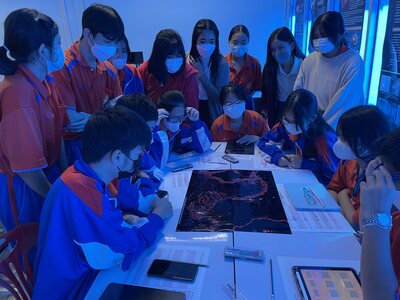
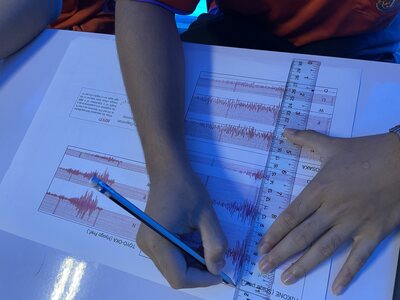
The well-known 3D epicenter map. Students' reactions were very positive. Some students were able to guess the principle of the earthquake almost accurately.
This is also a familiar exercise to find the epicenter from the JMA earthquake records. I feel that the students seemed to take it in more quickly than with the teacher, perhaps because this was the second time for me to teach this exercise, and I have improved my teaching skills.
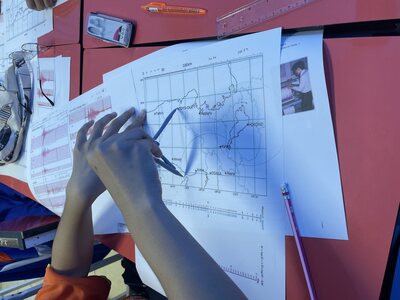
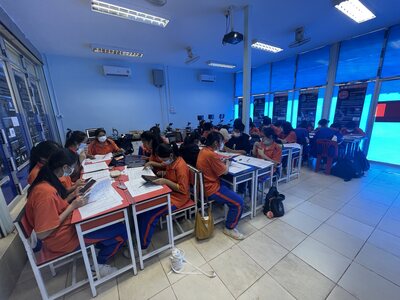
Practice to determine the epicenter with a compass. The concentration of the compass circle was better than that of the teachers.
This classroom is prepared to astronomy, and there are many telescopes in the preparation room on the left. The high school is located far from the center of the city, so the stars can be seen very beautifully at night. The reason why some of the pictures are blue is because of the blue sheet for shading in this room. (Postscript. I actually looked at the sky outside my room at night, but the nearly full moon was in the way and I could not see the darkness of the sky. However, the sharp brightness of Jupiter and Mars also revealed that the sky conditions were quite good.)
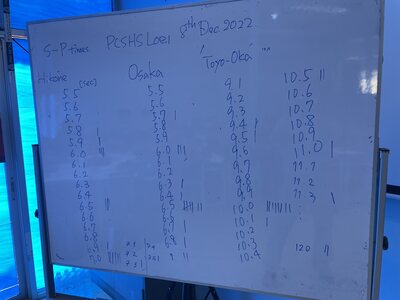
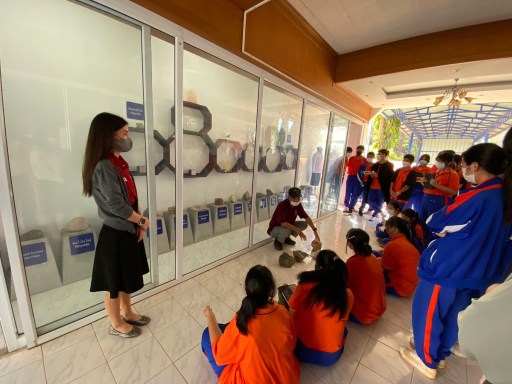
I am collecting frequency distribution data of students' S-P time measurements for my own research, with their help. I feel like writing a sequel to the JMA record paper I wrote a long time ago.
Here is today's geology lesson. First, in the science building, I find a display of rock samples donated by the University of Khon Kaen and awards from various science competitions, which I take out and explain to students one by one. I was allowed to break the rock with a hammer, so I tapped the edge of the rock to reveal a new surface and explain how to look at it. Other students and teachers look at the rock with interest and pass by. A science teacher took the photo.
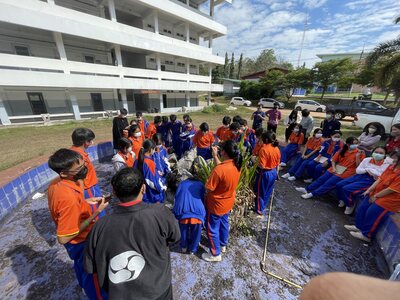
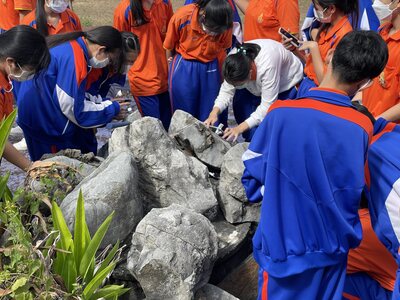
The students are taking pictures of the fossils with the close-up lens for the smartphone that I lent them. I was impressed by the students' enthusiasm for observation.
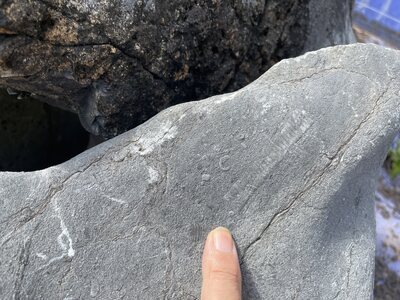
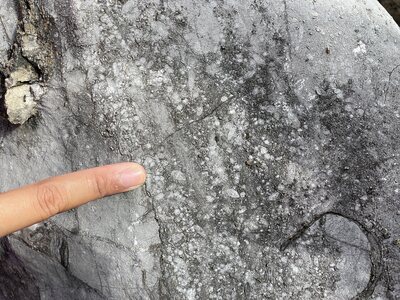
The longitudinal and transverse sections of the stem of the crinoid (sea lily) are beautiful. I was so excited when I found it in the morning. I asked my students to look for it, and they found it immediately.
This one was a little more difficult for the students to find, but the
winding of the fusulinas was clearly visible with a loupe. I let the
student look through the loupe. He deftly took a picture of this one,
too. On the left, you can see some scattered fusulinas by naked eyes.
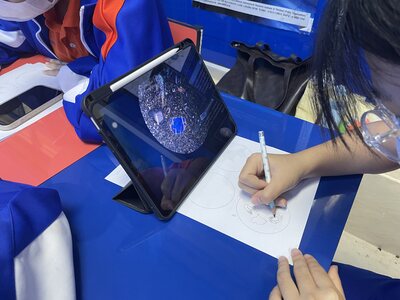
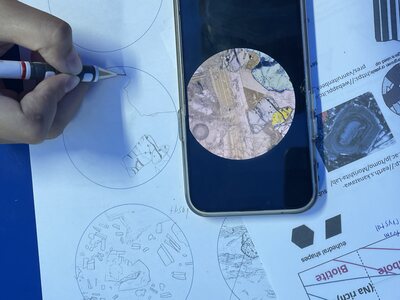
In this case, we observed a thin slice of rock, but we did not have enough microscopes, so we devised a plan to have the students take pictures with their tablets or smartphones in sequence and make sketches based on the pictures. This is a method that I learned from the students when I did the same observation at an affiliated high school a long time ago, using a smartphone in a way that I had never thought of.
his student is using a picture from his smartphone. The only problem is that whenever I ask them a question, they immediately tries to Google the answer on their smartphone or tablet. Think for yourself! I advised them several times with a smile.

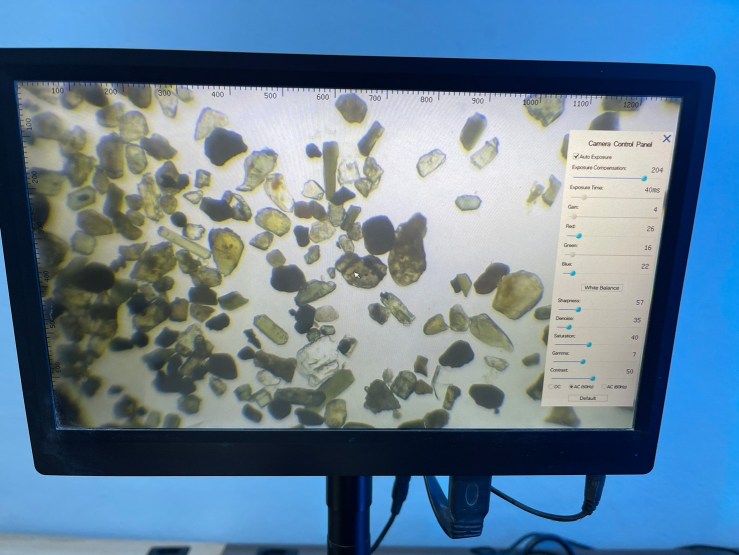
https://www.lazada.co.th/.../akadama-i3133034444...
This is also a standard observation of volcanic ash using akadama soil. There is no running water in the room, so we are crushing and washing akadama-soil in the bathroom nearby. Until the other day, I thought that akadama soil was not available in Thailand, but I was surprised when I looked it up today. I found it at LAZADA, a Thai net store, at a reasonable price!
https://www.lazada.co.th/... /akadama-i3133034444...
Beautiful ortho-pyroxene and others were extracted. This
is the LED
screen on the 3-axis microscope. I got this photo from another teacher.
using a magnet, the students recognized some magnetic minerals such as
magnetite.
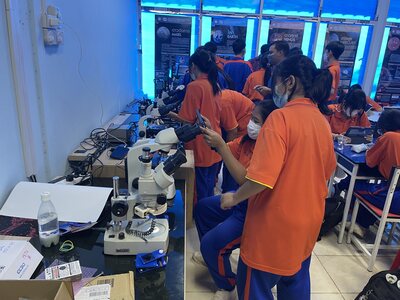
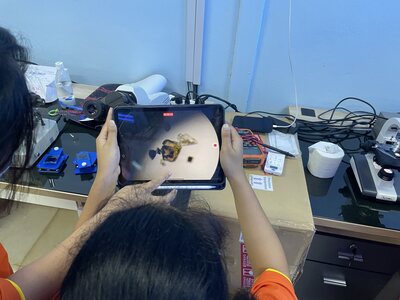
They are trying to take pictures with their smartphones and tablets. The school also has a junior high school, where the high school students wear orange and the junior high school students wear blue. It is a boarding school, and all tuition and dormitory fees are covered by government scholarships. The level of the students is high, and one of the students I talked to who understood very quickly told me that she was aiming to go to Mahidol University and that she wanted to become an engineer in the future.
The tablets are heavy and I am having a hard time getting them into my field of vision. The boy next to me is helping him. If I come here next year, I will definitely bring a 3D printer adapter for microscopy.
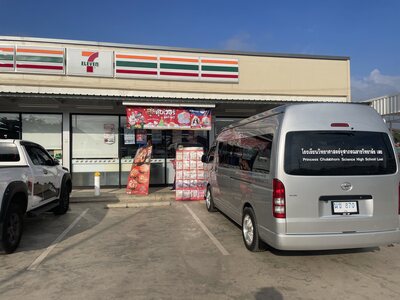
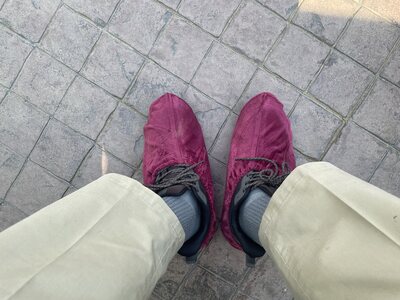
Now comes the main event of the school. The first day of earth science training is about to begin. About 10 teachers and 20 students are in 4 school vans. We took a morning break at a 7-Eleven as usual. We took a restroom break and had a drink. This teacher loves to drink and always buys something. I also imitated them and bought a coconut juice.
This is the entrance of "Sky Walk", the day's first destination. Here you can buy shoe covers like the ones you see here for 40 baht. The school bought them for me along with the admission ticket. I was allowed to take them home with me, and they will be my slippers for my stay at the hotel later.
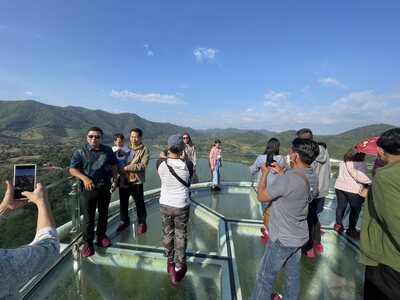
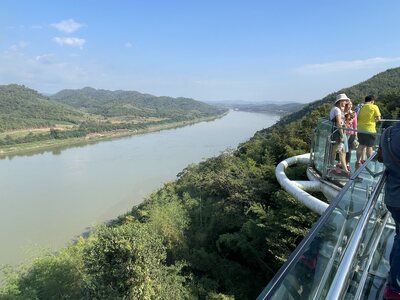
SkyWalk is located near the border with Laos and has recently become well known in Japan through the introductions of YouTubers living in Thailand. This is the point where the rivers on the Thai side meet from the left. The Mekong River, which has been making the border with Laos all this way, leaves the border here and enters the Laos territory. It is Saturday, so there are many tourists, but most of them are from Thailand. Everyone is wearing the shoe covers to prevent damage to the glass on the floor.
Looking downstream. The river is flowing slowly here, but it becomes rapid downstream where it flows through the mountains. This is the area around the café shown in the previous photo.
The other side of the river is Laos territory. The culture and history of this region is said to have many things in common with Laos.
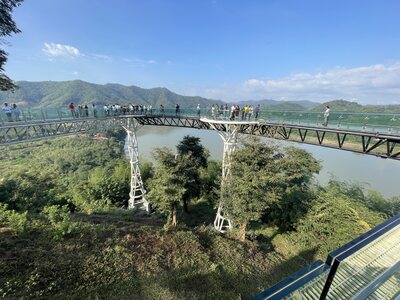
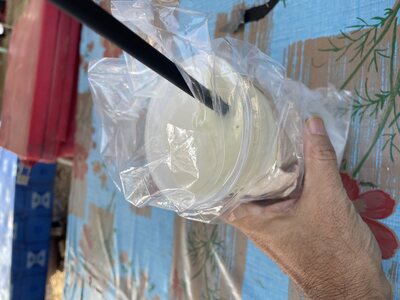
The corridor is not as scary as I thought it would be. It is quite high, though. The weather in northern Thailand during the dry season is very pleasant, making it a perfect place for sightseeing.
The vice-principal who accompanied us gave me a coconut shake. He even bought me a T-shirt as a souvenir.
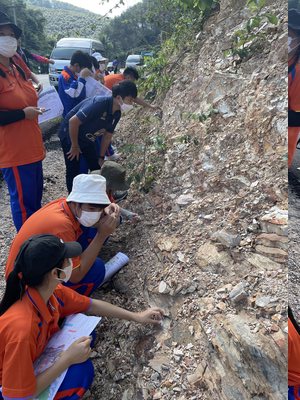

This is the roadside outcrop we stopped at on the way home. I had not marked this location at all, but it was a great place to see the strata, and I spent an hour explaining and discussing the strata with the students. The geological map shows the site as colored Permian sandstone, siltstone, and mica shale. 12/16 I will add the interpretation of my old friend, Dr. B, who specializes in sedimentary rocks. He said it was just his impression based on the photo.
It is a good outcrop with a really textbook layered structure. The
entire outcrop seems to be a little bit gently anticlinal. The contrast
between the white and reddish brown color is due to: 1) the presence of
fossil vegetation on the geological map, 2) the lack of water flow
tracks (cross lamina, ripple marks, etc.), and 3) the lack of a
sandstone gradation structure. 2) The sandstones do not show much of a
clastic structure. The reddish-brown color is probably the result of
sedimentation in a quiet lake, not in an ocean or a freshwater river.
The reddish-brown color can be explained by the fact that the sediments
were deposited by oxidation due to some environmental change.
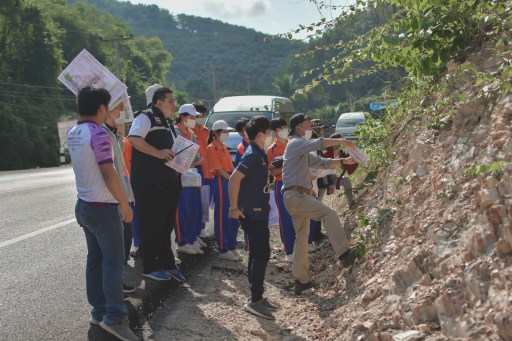

The students were watching me during my performance of the dip of the strata. The black wearing man is the vice-principal who followed us for the first half of the presentation.
If someone records my explanation on the site, please send me the video.Teachers of other subjects are also discussing, looking at the materials. It is a little scary due to close to the road, but the road is wide enough, so it is a very good place to visit.
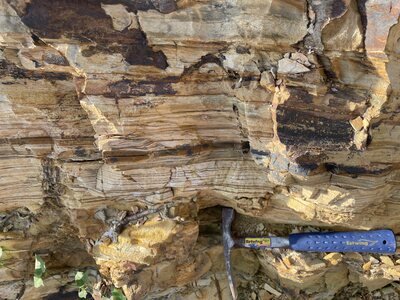
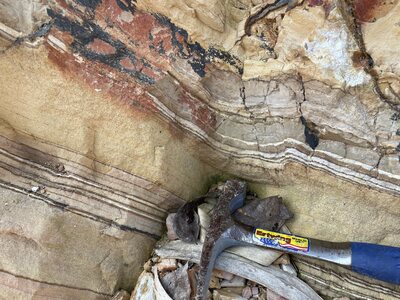
FBを見ておられる専門家の方なら,どうお答えになるでしょうか?私にはとても難しいように思えます.一応赤い部分は環境の変化で酸化した層だろう,と適当な答えしかできません.ということで別写真で解釈を書きました.湖成層という解釈です.
Here is the fine layer pattern. I have been asked many times by my students about the difference in color.
What would an expert who follows FB say? It seems very difficult to me. I can only answer that the red part is probably an oxidized layer due to environmental changes. So, I wrote my interpretation on another photo. It is an interpretation of lake stratification.
The stripes here are also very beautiful. It is not a lamina but a layered structure, right? According to Dr. Bessho, my old-friend; the difference between lamina and stratification should be defined by the thickness of the lamina. However, I cannot find the literature on this at this time. He said that fine white and reddish-brown stripes should probably be considered as lamina. He pointed out that what should be observed first are details related to the vertical stratification of the strata, such as the gradation of the sandstone and the way the lamina is cut. If there are plant fossils, they may appear when this lamina is broken. He also pointed out that to determine whether a certain layer contains volcanic ash or not, we need to remove the grains and expose them to water and observe them under a microscope to see whether volcanic glass can be seen or not. This is something we will have to do next year. This alone could be used as a half-day to one-day geology study tour site.
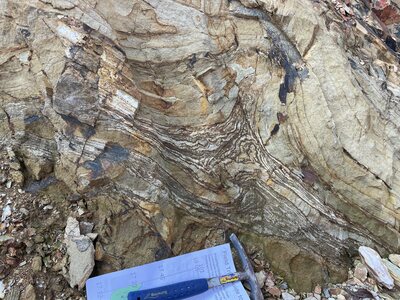
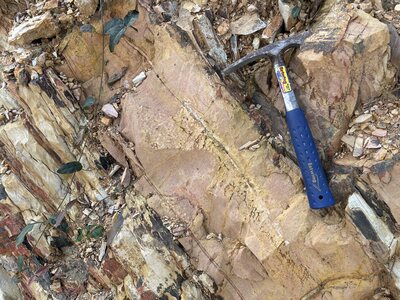
This is also a magnificent part of the slumping. It would take half a day to see all of them. I would like to have another chance to visit this place. Dr. B said that this also occurs without marine turbidites, and it cannot be said that it is a marine deposit. He also said that it would be difficult to judge whether the stratum is upper or lower.
Finally, we found a layer of sand. The color is a mixture of yellow and brown. It is a layer that can be discussed in various ways when we think about what kind of environmental changes it may have undergone. In addition, there was a thin layer of bright pink like volcanic ash among the black-colored strata, and I never got tired of looking at the place. However, I had to leave this place with our next schedule.
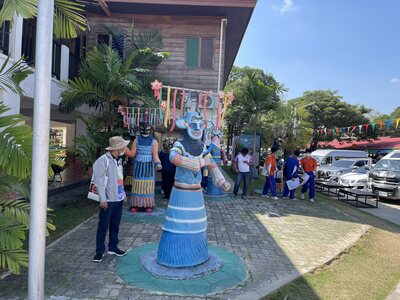
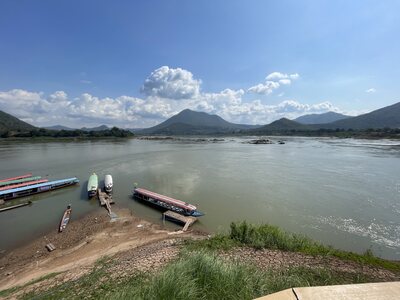
Here are some decorations of "Peter-Corn", a local tourist attraction, where we stopped for lunch. This character is all over the tourist attractions here.
This is the place where a rock dyke runs through the middle of the river, as seen from the cafe above during the drinking party the other day. Legend has it that a giant once fell asleep here, and became a rock bridge through which the locals could pass. The river meanders greatly to the left and becomes somewhat rapid. The rock seems to be a slightly metamorphosed basalt or dolerite, as we will see later.
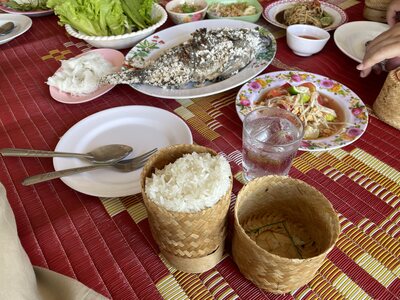
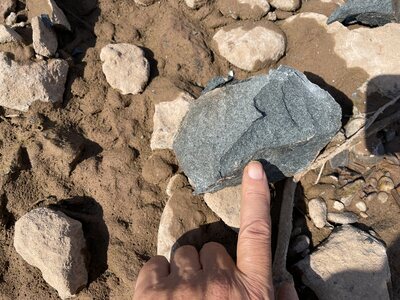
Lunch was served at a restaurant on the terrace of the river. Today's meal was sticky rice. Various dishes were served on plates. As usual, the fish are the big fish from the Mekong River. The dish in the foreground is the famous papaya salad, Song Tam.
I examined the stones on the riverside for a while. It seemed to me that it might be metamorphic basalt or dolerite, but there is no description of it on the geological map. I did not want to take the stones home because this is a historic site. When I checked the stones on the riverside a little further upstream, they were slightly metamorphosed limestone and greenish phyllite-like stones. Except for the limestone, these are not well described on the geological map, so I plan to study them in the future.
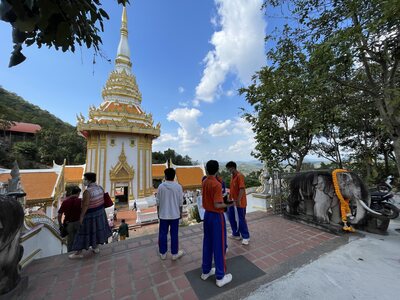
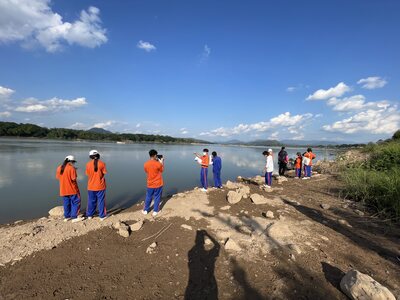
On the way to the outcrop described in the last paper, we visited the precincts of a temple that Dr. S visited for a preliminary inspection. There was a granite outcrop here, but it was somewhat weathered. It's a pity.
I looked for the location of the paper, but all I could see was the surface of the river, which may have sunk below the surface due to rising water. That was the end of my itinerary for the day. From here, we returned to the school through the mountains. It was a very fulfilling one-day field trip.